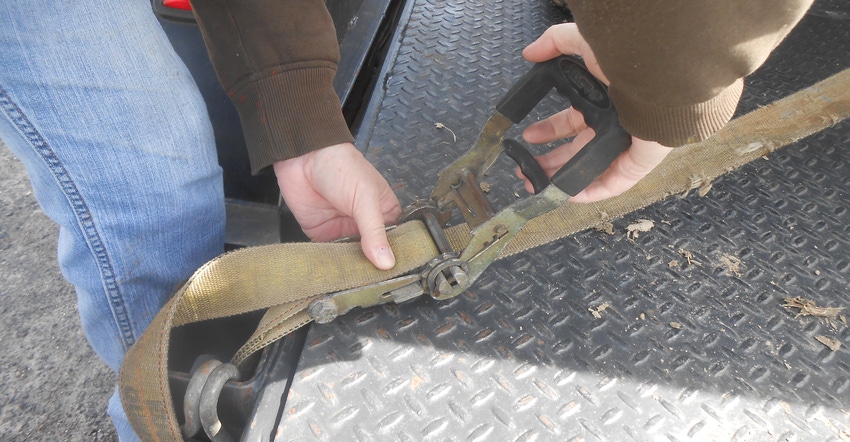May 15, 2019

How many times have you heard this remark just after loading hay bales or a piece of equipment onto a truck bed or trailer: “We don’t need to tie it down. We are only going a short distance.” Wrong.
Well, it might seem like a way to cut corners by skipping the tie-downs, but cargo of any kind should be secured for safe transport. Anything could happen with loosely loaded cargo, which has the potential to cause damage, injuries or even fatalities.
Here are some safety concerns to keep in mind when securing cargo with tie-downs.
Integrity of ratchet and strapping. Before using tie-downs, inspect the ratchet and strapping for safety. Weather and wear can compromise integrity. This brief inspection for fraying of strapping or faulty ratchets can avoid disastrous outcomes.
Minimum breaking strength and working load limit. All manufactures of ratchets and strapping must be labeled with a minimum breaking strength (MBS), as well as the working load limit (WLL). The MBS is the minimum amount of weight withstood resulting in failure. However, keep in mind that any tie-down is only as strong as its weakest point in the ratchet-strapping system — thus, the need for the inspection, as previously noted.
The WLL is the maximum load assigned to the ratchet-strapping system. There is a cardinal rule that this should never exceed one-third of the overall breaking strength.
In the case of the MBS and the WLL, err on the side of caution and do not overload the ratchet-strapping system.
Almost ready for transport? Once all strapping is in place, do a double-check to see that the tension is tight. If there is anything sharp that the strapping crosses, a buffer is often needed, to avoid having the metal cut or fray the strap. Also, remember to tie up loose ends — literally. Any dangling straps should be knotted and secured to avoid wrapping around wheels, axles, etc.
During transport. Once in motion, remember to check on the load. Potholes, ruts and any type of jarring can loosen the strapping tension. Slack in the straps can potentially result in the load shifting, or even loss of the load — especially if the strap hook(s) lose connection.
After transport, maintain integrity. After transporting your cargo and removing the strapping and ratchet system, proper storage of the tie-downs is needed to maintain their integrity. Moisture, mold and even direct sunlight can damage the strapping as well as the ratchet.
So, when it comes to transporting cargo, remember that any distance traveled should be safe. Do it right, and tie up loose ends. You do not want to be “that” farmer with hay bales rolling down the road.
Tomko is a professor and farmer who writes from Rittman, Ohio.
About the Author(s)
You May Also Like




